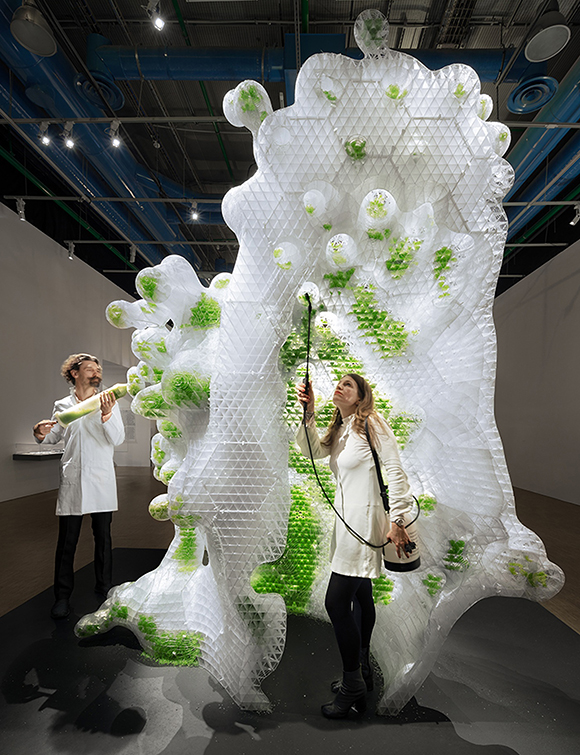
H.O.R.T.U.S. XL absorbs CO2 from the atmosphere
The art installation is the world’s first 3D printed bioreactor. It was created by the CREATE Group from the University of Southern Denmark using a technology that can help solve the major climate challenges.
It is crucial that we reduce world CO2 emissions if we are to succeed at limiting global warming to 1.5 °C. These are the words of the growing number of reports from the Intergovernmental Panel on Climate Change.
But even if we achieve the objective of reducing the world's total CO 2 emissions to zero by 2050, it is not enough. We actually need to become emission negative, and that requires technologies that can absorb CO2 from the atmosphere.
Scientists around the globe are therefore busy developing a technology with that property. This issue is also being worked on at SDU. A group of SDU researchers, known as CREATE, have developed an art installation that converts CO2 into oxygen. This has been done in collaboration with the company ecoLogicStudio.

Microorganisms at work
The installation, called H.O.R.T.U.S. XL, has been exhibited at the Centre Pompidou in Paris and the Mori Art Museum in Tokyo.
ecoLogicStudio
is a company that specialises in environmental design and urban self-sufficiency. The company tries to integrate nature and architecture. Researchers at SDU have developed H.O.R.T.U.S. XL in collaboration with ecoLogicStudio.
H.O.R.T.U.S. XL is a digital algorithm that has been used to develop and produce an organic shape which forms tiny, tailor-made construction blocks. The blocks are implemented in a cleverly conceived hexagonal grid with a height of just 320 mm.
These structures were then printed by a 3D printer and used for the art installation. What is special about these 3D printed units is that they are inoculated with cyanobacteria, which are microorganisms that convert CO 2 into oxygen.
Sustainable architecture
When H.O.R.T.U.S. XL is on display, visitors are able to move freely around and inside the installation and observe the subtle bio-digital landscape. Each time the visitors breathe, they interact with the installation, as the microorganisms absorb CO2 produced by human breathing and transform it into oxygen.
Cyanobacteria are able to absorb 10 times as much oxygen as trees, which means that the prospects it offers are great, even though the research is still in its infancy.
“In this jointed research, biological and digital strategies are fused together to conceive a novel model of architecture, able to contribute positively to the urban environment,” says SDU researcher Roberto Naboni, who is the coordinator of the project.
Perhaps we are looking at a future where architecture, buildings and installations will help to reduce the concentration of CO2 in our atmosphere.
What are cyanobacteria?
- You may be familiar with them from hot summer days where, under the more idiomatic name of blue-green algae, they caused the Danish Environmental Protection Agency to hoist the red flags at beaches and lakes and prohibit bathing.
- High concentrations of blue-green algae – which are actually not algae, but a bacterium – are poisonous and can cause skin irritation and stomach cramps.
- Although cyanobacteria can cause harm to animals and humans, we should thank them mercifully. It is believed that it was precisely this organism which, between 2.3 and 3.8 billion years ago, developed photosynthesis and produced the oxygen that is essential to life on Earth.
Meet the researcher
Roberto Naboni is an Assistant Professor at the Department of Technology and Innovation. His research focuses on developing visionary architecture and design concepts using new materials and advanced production. Part of his research includes how concrete elements can be manufactured using a 3D printer, thus optimising material consumption and increasing strength and durability.
CREATE
- The CREATE group explores novel architectural processes and solutions in the tension fields between computer science, advanced manufacturing and emergent material technologies.
- Among other things, the group focuses on 3D printing and architectural robotic technology, using materials such as bioplastic, clay, concrete, silicone and wood.
- CREATE was founded in 2018 by Roberto Naboni, who is also the Director of the group, which is part of SDU Civil and Architectural Engineering.